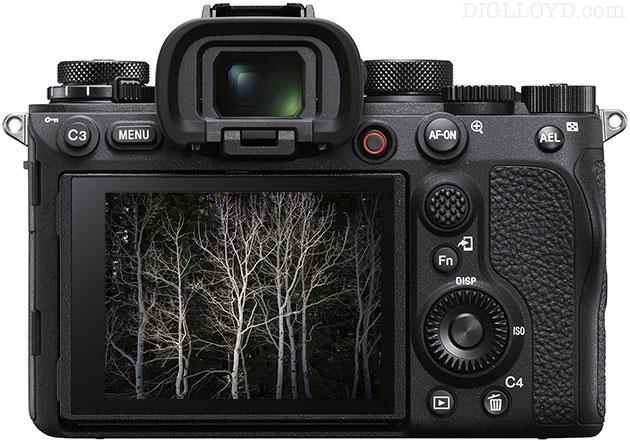Fujifilm GFX100S vs Sony A1: thoughts on Enjoyment, Hit Rate, Image Success + Reader Viewpoints
re: Fujifilm GFX100S or Sony A1 or Sony A7R IV for Landscape, Studio, etc?
re: Why I Bought the Fujifilm GFX100S (and why I’m also buying the Sony A1.
This essay speaks to considerations that have nothing to do with technical specifications. I couldn’t not write this, as I feel it’s too important a decision point for anyone thinking that medium format is necessarily superior to the 35mm-format option. Subjective...totally, relevant to a choice—absolutely!
...

The prior two nights I had shot the Sony A1 with the Sony FE 50mm f/1.2 GM and then the Sony FE 35mm f/1.4 GM. With that setup, my “flow” just seemed so easy, and very enjoyable.
But last night, the GFX100S felt like a chore by comparison, and I ended up discarding all my images—none satisfied. It feels hard to compose through its EVF, which sucks in color and contrast and detail along with magnification that just somehow does not work for my eye. I did focus the EVF (diopter adjustment), so that’s not it. Each time I pick up the GFX100S, the view feels just as crummy as the last.
The EVF matters a lot. GFX100S AF sometimes nails it and sometimes misses, so I cannot rely on it for precision focus. And its magnified Live View is at best fugly compared to the Sony A1. And when the EVF is not a pleasure, all aspects of usages suffer, like composition (at least for me), and even psychological ones—the appeal of what I am seeing and therefore wanting to make the image.
Those are just operational things, so do they matter? I think so, big time. At least for general image making. That is, when I look at images, the Sony ones are much more numerous and on average much better—more pleasing. So I get 50 megapixels instead of 100, but I like what I made a lot more often and with a lot more images.

And I got to make those images while enjoying the experience, not resenting the aging dumbed-down technology (in the GFX100S).
I am not claiming that the GFX100S images are technically inferior. Presumably they are as good or better in some technical sense, but so far I like the Sony images far more—color and contrast, lens rendering, and overall visual impact—totally in favor of the the Sony A1 with the 35/1.4GM and 50/1.2GM vs GFX100S with 50/3.5 and 30/3.5. And vastly more flexible—even in equivalent aperture terms, we’re talking two full stops more creative potential with Sony, and with razor sharp results wide open—the Fujifilm lenses suck wide open at f/3.5. Totally different too sets, one of which isn’t even competitive for many things (GFX100S).
Image-making should be enjoyable with a high hit rate making images that please. The Sony A1 does that. The Fujifilm GFX100S has not yet made me feel good.
More concerning is that the Fujifilm medium format platform fees stuck in a rut in terms of buttons, dials, menus, AF motors, EVF, scrolling speed, slow transit time, etc. Will it ever leap forward to much better usability, to Sony A1 grade?
And will Sony ever take Sony A1 technology and make a medium format system? Not likely, but it would bring welcome competition—would be awesome.
In the field
Out in the field (soon), I’ll have a chance to make landscape images with both cameras, where the shooting style is quite different. I am expecting that the GFX100S will earn its keep by delivering images with considerably more detail. And in such situations, it should earn its keep.
Thing is, the Fujifilm GF 30mm f/3.5 is a big disappointment—it just does not deliver the goods, not for a 100MP camera, and I despise the fact that f/3.5 is a useless crappy aperture. And the whole point of a 100MP camera (for me) is about capture detail. With that big "hole" in the lens lineup, I now need to find a good sample of the Fujifilm GF 23mm f/4.
Claude F writes:
There's no question that the Sony with all that you have noted is a robust image maker and an enjoyable photo experience. Sony has upped the game from the A7R2! The lenses are now world class with the camera to match.
My overarching goal has always been 4x5 image quality but that needs to be achieved in the first place. And then can't turn into a chore in the digital darkroom. So the 100s remains an open question for me. Can I quickly and accurately focus and get an image handheld. Will Focus BKT work. I have no problem using smaller apertures and smaller step sizes. I know smaller apertures are a problem in your play book. Will I have a straightforward time working with files. A big question is using Helicon or Zerene stacker with BKT images. If I start to struggle or have any difficulty along the way it's not worth the fight. Most of the time workarounds suck.
As a landscape, mostly tripod based, and very low shutter count photographer, shooting in remote places, and looking to make crafted images, the 100s would seem to be the hands down camera choice. That said the workflow needs to be a flow and not a chore. The camera lens system needs to be reliable in several ways. Momentary or longer camera problems, for instance one that requires removing the battery or one that locks up the camera into an unusable brick are not something most are going to want to contend with four miles or 400 miles from the car.
The most important step in the flow, I use the word flow with strong intent, needs to be the confidence that the exposure made for the hard earned composition is rock solid. Like the 4x5 camera for me, I need to know that when the film came back or the download is made to the computer, I got what I needed in the field. I don’t have time or the inclination in most of my shooting environments to review frames or make adjustments. I’m usually afforded a single set of bracketed exposures at the optimal moment of exposure.
An important consideration for me with a new camera is the ability to hand-hold, and with the same confidence I’m describing, make the photo I’ve envisioned. The ability to stop and take a photo is something I rarely do in the Sierra, but in Alaska or Himalaya the lighting and subject matter that presents itself makes handholding for a photo a necessity. The obvious camera and lens feature would be to make autofocus photos with confidence. Something I have little or no confidence in, but in the mountains I’m traveling to, I do need a handheld photo to work without question.
Beyond the operation of the camera of course is the image quality which unquestionably lands in the GFX100S court. Yes, as long as one got the shot I know. The point I want to bring up is that the flow needs to continue to the image processing portion. After a trip I have lots to catch up with not the least of which is going back to work. So when I get around to downloading and doing a cursory review and maybe begin rendering stitches or my upcoming focus bracketed frames that too has to be straightforward. I’ll stop there as it’s time to head to work, but I am excited to get into a flow that I trust and hopefully have fun with.
DIGLLOYD: makes sense to me—the Fujifilm GFX100 worked great for landscapes for me in the past, and the GFX100S should be no different. That’s what I alluded to in my last not in my essay.
YES, the FOCUS BKT feature will work with shorter focal lengths such as 50mm. I tested it and it worked fine with the 30mm and 50mm lenses. Worst case if it happens is to take one last INF image and/or try Auto with near/far points.
Autofocus—I am seeing too many misses to assume it's solid; for landscape I strongly recommend popping into 100% magnified Live View to verify.
Michael Erlewine writes:
I totally get your post about the awkwardness of the medium-format range of cameras. Starting with my Mamiya RZ67 system, which I bent over backward trying to like, but couldn’t. It was the same with the Fujifilm GFX-50S, I was grossed out by the haptics and all the things I had to sacrifice to gain what was supposed to be a much better image, an image I never seemed to be able to find etc.
And I believe I tried the Sony A7R cameras, I hate to say this, three times, always sending them back. I believe I could like the Sony A7R4-a, the forthcoming one with a better back-panel LCD and am thinking about it.
So, it comes as no surprise (or a pleasant surprise) to read your haptics (or whatever) take on the GFX100s. It feels that I am finally back on the same page with you, where I felt I used to be.
I am looking forward to Nikon’s response to the Sony A1, hoping it will come close to the A1 and still have all the things I love about the Nikon System. And, if they would come out with an A1 with a decent rear LCD, I might sell some rare lenses and buy a copy. Until then, not likely.
I am quite happy with the Nikon Z7 II, even though I know it is not as good as my bulky Nikon D850, which I seldom use lately. I never have printed out even one image of the hundreds of thousands of images I have taken over the years, much less put one on the wall. Does not interest me.
I really do feel we are at an inflection point in modern photography, and I am finding myself turning backward and being pretty content with what I have and wondering if the pursuit for larger sensors really matters that much for me. 40-50 megapixels seems quite reasonable and 100 Mpx beasts like the Fuji cameras not worth the sacrifice in haptics it would take.
I totally am on the same page with you about the joy of good haptics and not having to hold my nose using a technically more capable (perhaps) camera system, one that if I am honest, I just don’t like.
For myself, I feel I have reached the point of no return coming back for me, a point where I turn and work on being content with what I am told is an inferior camera (Nikon Z7 II, etc.), but one that is a joy to use. I guess I am now sacrificing more pixels, etc. in favor the shooting experience as you subscribe.
And I have at least 6 Sony lenses that I use with an adapter on the Nikon Z7 II, all very nice Voigtlanders, ready for a Sony A7R4a or the A1 camera… perhaps.
DIGLLOYD: all the mirrorless cameras today are making us spoiled. But at this point, Sony’s lens line leaves all other brands behind; though each vendor has some outstanding choices, Sony has far more.
Roy P writes:
You heard me on the GFX100S usability issues almost immediately after I got my hands on it. Of course, it sucks. I seriously considered sending it back. I am still within the window of returnability, so sending back the camera and all the lenses is a thought that has occurred to me a few times.
In the end, I have gotten over all the irritations and frustrations with the camera and decided to keep it, based on the following considerations:
#1, the camera / lens doesn’t take photos, I do. And despite all the nuisance factors, I have and I can put it to work, and for my intended use cases, I can get good results with it. So far, I have not been disappointed with the image quality it has delivered. The GFX100S has the same sensor technology as the Sony A1 and the Phase One IQ4/150MP should also be closely related. Inherently, the GFX100S should be capable of delivering the same world class images with the best lenses, and I believe it is.
[diglloyd: it is my understanding that the A1 sensor is an upgrade to the A7R IV/GFX100/GFX100S/Phase One IQ4 sensor tech]Each of these sensors is unique to the camera it’s put in. The sensor is not just the array of photo cells, as you know. It’s the entire CMOS stack with the integrated DRAM, all the embedded AF points, sense amps, buffers, etc., and the A1 and the GFX100S sensors are very different that way. The GFX100S sensor is probably the same as the one in the GFX100, so that would make it a year older, and perhaps it has more in common with the A7R4. But in the big picture, all these and the IQ4/150 are within the same 1-2 year time window to be called the same “generation”. But the A1 is obviously the sensor with the most steroids injected into it!
And that leads to #2, lenses. I can’t speak for all GF lenses, but among the ones I’ve seen so far, the 80/1.7 and 110/2 look world-class in absolute terms, while the 32-64, 45-100 and 50/3.5 are excellent for my intended use cases (walkaround / street, people and macro photography with extension tubes and focus bracketing). I have also picked these lenses such that I have minimal overlap or redundancy in terms of use cases with Sony and P1.
#3, in terms of usability, compared to some of the other systems I’m used to, namely P1, Leica M, and Leica S, the Fuji is like traveling by First Class. The Fuji is a dwarf in the Sony, Canon and Nikon circles, but is a giant in the P1, Leica M and Leica S/SL circles (don’t know about Hasselblad). You can make very good pictures with even the most cumbersome of these systems, so in the full spectrum of the cameras, the Fuji is more like in the middle of the road rather than an extreme. At a price of $6K, its value makes up for a lot of usability issues!
#4, the GFX100S is not devoid of capabilities and competencies. It does some things that the Sony and P1 can’t do. For me, the GFX100S has shown superb capability with flash photography, far better than either the Sony A1 or the P1 XF. I take a lot of people photos (events, portraits), and I use Profoto flash. The Sony, Fuji and P1 all work with the same set of flashes, and the GFX100S has become my most go to camera for flash photography.
#5, Much of the GFX100S’ usability problems can be fixed with firmware upgrades, and if a lot of people complain, over time, I’ve got to give Fuji the benefit of the doubt that they will improve the camera. They had the vision to produce the GFX 50 cameras, then the 100, now the 100S, and to offer it at such an aggressive price. This is a company that has come to fight to win this camera category. So my take on the GFX 100S is, worst-case, consider it a beta product, and the real product will be the Mark II, perhaps 18 months from now. But in the meantime, the Mark I is not so badly crippled that it can’t be used, and when a Mark II comes out, the current version should still be sellable for $4000+. So my rationale for keeping the GFX100S is not based just on the GFX100S per se, but rather, a commitment to this sensor size, which I’ve always liked since my Leica S2 days (2009). In that context, the GFX100S Mark I specifically is something that comes and goes.
So that’s my rationale. I’ve decided to keep this, warts and all.
DIGLLOYD: me too (keep it). And I agree with the reasoning.
Jon M writes:
All this talk about which sensor is better, the same, worse or needed size has had me thinking that one major aspect is being ignored – how the image will be viewed. The prevailing conventional wisdom being circulated now seems to go something like this. Who needs 100/150 MP to view an image on your phone, Instagram, Flickr, laptop, etc. (pick your own poison)?
You only need a lot of pixels if you are going to make a large print or view it on a large ultra-ultra resolution screen, but very few people view images that way and, even then, you can probably get away with using Gigapixel AI or Adobe enhanced images, etc. The only people that care about high pixel counts are pixel-peepers (and we all know that they are the lowest form of human being there is!).
But, hold on – isn’t that precisely the point. Now that technology has given us different ways of viewing images, shouldn’t we give people the opportunity to see images in different ways. I might want to see the whole composition of a landscape and admire it but also enjoy zooming in and noticing a well defined image of the rare bird in one of the tree branches.
What do you think?
DIGLLOYD: my daughter takes beautiful pictures with her iPhone 11, in HEIC or JPEG. Then when I bring them up on my 2019 iMac 5K, the compression mutilation and posterization makes them no good for better than 1/4 of the screen. They work well for some subjects (in small size) and are a disaster with others.
Pixels are now about image quality as much as “detail”. Fidelity to the scene. Many natural scenes look like mutilated yuck when the pixel count is too low. Add in color aliasing, color speckling, stair-stepping, false detail, coarse tonal transitions, inaccurate colors especially details, crisp textured snow or sand that turn into finger-painted mush, etc.
Cropping is an increasingly useful benefit of more pixels, particularly for wildlife.
Barring exotic gear, never before could we hold in our hands a camera capable of capturing more than we can perceive while there, and explore it later.
I enjoy the details in a scene very much, but unlike printed images, I can zoom in and explore things that I didn’t notice while there—a remarkable and unprecedented benefit in the history of photography. For any number of images without making a huge expensive print that won’t fit into my home anyway, and that would demand I be X inches away to view it properly. Prints are a terrible solution for enjoying more than a tiny number of images and they severely limit our perceptual enjoyment.
We all perceive the world differently—color, shapes, etc. It’s brain wiring. I saw this early on in my youth—my brother always saw the arrowhead first, the deer in the woods, etc. it always frustrated me that he was innately better at those sorts of pattern recognition things—but why should any perception or skill be thought to be “the same” with different people? It’s not.
I think the “disagreement” about resolution might come down to different sensory processing. Which relates back to image quality which directly relates to sensory processing. We are not the same, so the whole argument is foolish because we are each ourselves.
In particular, sensory processing sensitivity means that when I look at a landscape (in the outdoors), or an image of it, there is a lot going on that I am certain does not happen for others. In the actual outdoors, it’s a multi-senses experience, which is perhaps why I like spending so much time outdoors. Whatever the experience is, catpSo it make perfect sense that what I need in an image has no value for some.
Sensory processing sensitivity (SPS) is a personality trait characterized by a high level of sensitivity to external stimuli.[1] The trait tends to correlate with a greater depth of cognitive processing and high emotional reactivity.[1] A human with a particularly high measure of SPS is considered to be a highly sensitive person (HSP)...
According to the Arons and colleagues, people with high SPS make up about 15–20% of the population and are thought to process sensory data more deeply due to the nature of their central nervous system.
I know that “iconic” sells, but it’s incredibly boring after the 10th spectacular picture of Half Dome. I like iconic images for what they are of course, but more interesting are the smaller vignettes in and under and around the iconii—this is where publications like National Geographic fail spectacularly, IMO.
The Sony kit
The 'killer' kit for Sony. Some of the best optics ever made for the 35mm format.
The Fujifilm medium format kit
The kit for Fujifilm medium format. IMO, the GFX100 should be preferred (better EVF, more robust build). But it’s larger and heavier.

|

|

|

|

|

|

$1799 SAVE $500 = 21.0% FUJIFILM 80mm f/1.7 GF R WR Lens (FUJIFILM G) IN STOCK in Lenses: Medium Format
|

|

|

|

|

|

|

|

|

































